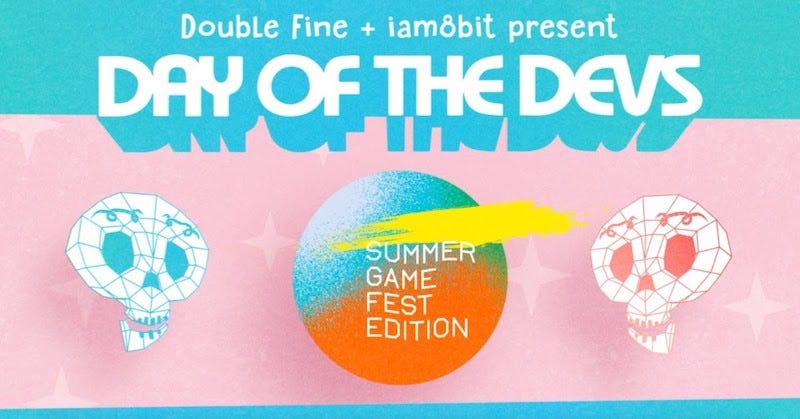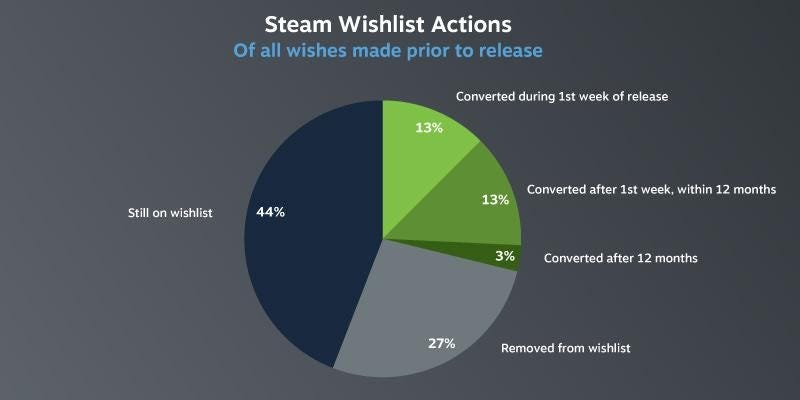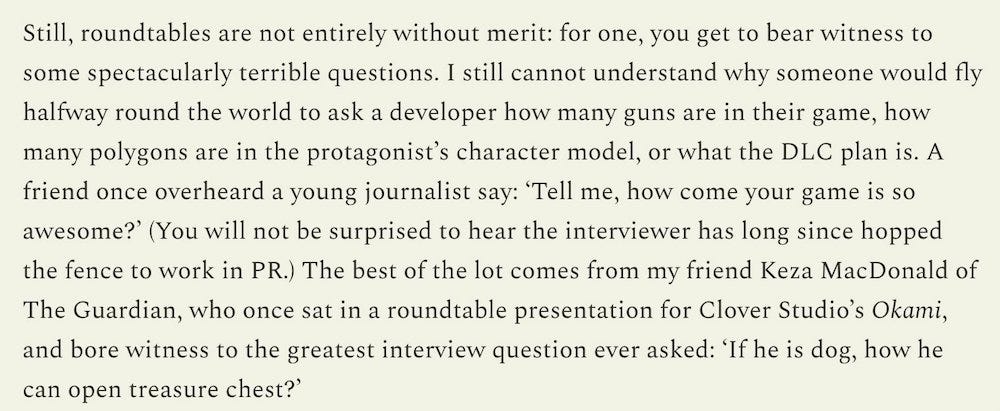E3 showcases - what discovery boost do they really give?
Publikováno: 14.6.2021
Who cares, and how much do they care? Some numbers.
[The GameDiscoverCo game discovery newsletter is written by ‘how people find your game’ expert & GameDiscoverCo founder Simon Carless, and is a regular look at how people discover and buy video games in the 2020s.]
Welcome to the jungle, we’ve got… fun and stats? It’s E3/Summer Game Fest week, and while all kinds of other newsletters and sites are doing a great job of saying what has been announced, and why, we’re trying to zag a bit - and take it from a different angle.
Specifically, if your game does get in one of the E3 showcases with your game, how does the extra visibility help? And how can we quantify that? Let’s take a look right here…
(REMINDER: being a GameDiscoverCo Plus subscriber helps subsidize free newsletters, and gets you ‘very friendly colleagues’ Discord access, Hype data back-end, extra newsletter analysis & more. Thanks in advance.)
Steam wishlists, E3 showcases, and thinking about expanded reach.
Whether it be E3-branded, Summer Game Fest-branded (excitable Geoff Keighley pictured, above), or just hanging out there in the virtual ether, the post-COVID June timeframe is busy, busy, busy for new game announcements or fresh showcases.
Even a close observer would have to admit things have got pretty crowded. Was interested to note that Annapurna opted to put their showcase on July 29th, and Axios’ Stephen Totilo commented - partly in jest - that even for him: “A surprising amount of my job covering games is realizing, oh, the beaver colony simulator I just saw a trailer for is not in fact-brand new -- but somehow I missed a demo for it a few months ago.”
It’s so hard to keep so many games straight! And all that hustling to get your game - whether a world premiere or just a new trailer - into one of the showcases? Was it worth it? Ways to measure the effect of a game being in a showcase would include:
‘total simultaneous viewers’ (actually quite complex to work out nowadays, because of re-streaming and multiple platforms. Guessing the shows are telling you estimates after the fact, though?)
general chatter about the game’s new social media followers, or Discord joins, or even Reddit upvotes - I noted Fancensus has been looking at top games’ press, Twitter & Facebook vs. Reddit upvotes in charts posted over on LinkedIn.
my absolute favorite metric: Steam followers and wishlists. You can view the effect on your wishlists privately. But everyone can see (via SteamDB and other tools like GameDiscoverCo’s Hype charts) the follower/ranking effect on games of any size. It’s a very useful tool.
Given that I talk to quite a few publishers and devs about their experiences, here are the three broad bands of visibility bumps that I’m seeing so far this E3:
Modest showcases: a feature meant 250-1,500 extra Steam wishlists on the day of the showcase, fading down over the next 3-4 days. (Think: shows like Indie Live Expo, Wholesome Direct, earlier shows like Guerrilla Collective’s first Sat., etc.)
Medium-level showcases: 3,000 to 7,000 extra Steam wishlists on that day (Think: Day Of The Devs this year, lower-end bumps for a PC Gaming Show feature - either higher viewership x lots of games, or medium viewers x less games.)
Big showcases/hot games: 15,000 to 50,000 extra Steam wishlists on that day (Think: big platform showcases like Xbox & Bethesda or the Summer Game Fest kickoff, anticipated announces with built-in fanbases - # can be WAY higher.)
Of course, it’s way more complex than that. Wishlists/interest are built off whether people actually care about your game. So your wishlist total for a showcase is a multiple of your ‘base’ wishlist rate/interest. And then you might be in multiple overlapping showcases, have a minor Steam feature etc. But look, benchmarks!
Related: I wanted to point out the effect of E3 showcases on Steam followers. You may recall that our survey revealed that Steam followers (“I want news/updates on this game”) and Steam wishlists (“Please tell me when the game is out/or on sale”) had a median and average relationship of about ‘1 follower for each 9.5 wishlists’.
Well, that ain’t the case for most of these E3 wishlists, which are adding around 1 follower for every 20-25 wishlists, in multiple examples I’ve seen. Uses those estimates, EA’s Battlefield 2042 added about 57,000 Steam followers on its first day after being announced. I’m guessing - though don’t have access to EA’s back-end, haha - that it’s more like 1,000,000+ wishlists. (Just the first day! Show-offs.)
How should you think about ‘showcase’ wishlists?
I’ve talked incessantly - and borderline annoyingly - about Steam wishlist quality - above pic from Valve via this GI piece - and so I think it’s worth revisiting briefly. Yes, given the high wishlist to follower ratios we’re seeing here, E3 showcase wishlists will be more casual than your average Steam organic wishlist.
Why? People are watching a whole bunch of games in a row, and may attract a ‘need to save this to remember for later’ wishlist action. In fact, I was chatting in a Discord to a number of ‘core’ Steam users recently, and was interested to hear two contrasting approaches to Steam wishlist management:
The disciplined wishlist queue: These folks “only wishlist the stuff they actually would want to play”, and have total unbought Steam wishlists of “a little over 30”, (trimmed down from 100), or in another case, a grand total of 80 games. If you’re one of those games, you can feel good about yourself!
The chaotic wishlist queue: This is much closer to bookmarking. Several people said: “I put in games I want to remember for later, or get discounts on”, or even “I [generally] put them in my wishlist to remember them for future bundles.” Examples of wishlist totals for this cohort included just over 300, nearly 900, and even 1900 games. (“I need more time in a day” was a mentioned phrase!)
So yes, I think game showcases attract more chaotic wishlisters than disciplined. But even if you take that into account, getting 5,000 wishlists at 50% or 33% or less of the efficacy of organic wishlists is still way better than… not getting any wishlists! Plus, you have the opportunity to build post-showcase buzz through word of mouth.
And aren’t we all becoming ‘chaotic wishlisters’ at heart, as Stephen Totilo hinted at earlier - just due to the sheer amount of great games and info about those games? Showcases are good because they cut through some of the noise. Just make sure you value the end results correctly.
(And to end, a request from the ‘core gamer’ Discord crew to platform holders: “Can we get custom wishlists so we can categorize them, instead of having behemoth lists that start to lose some of their function?” This especially goes out to Valve, but also other platforms that allow wishlists, like Nintendo or Microsoft. Message sent!)
The game discovery news round-up..
We’re mid ‘E3 globule’ here, so I don’t want to distract you all from the many massive announcements going on, such as the Intellivision Amico E3 press conference. But before we’re done with this newsletter, let’s look at the rest of the discovery and platform news:
As noted, there’s so much E3/Summer Game Fest game announces, I don’t know where to start. I liked Day Of The Devs’ more curated approach - here’s the featured games. But many other showcases had amazing stuff in them. Just go to the E3 Recap page and click around a bunch - it has easy trailer/game info links from the Future/PC Gaming Show, the Bethesda/Xbox shindig, and even less-appreciated events like the UploadVR showcase (highlights here!)
One big part of Summer Game Fest is playable demos. So just highlighting that in addition to Steam NextFest opening up on Wednesday, there’s a whole bunch of indie game Xbox demos officially becoming available on Tuesday via ID@Xbox. Appreciate the ‘here’s the cool games AND you can try them’ effort here - you used to have to go to E3 in person and only play like 3 games a day.
Checking in on a sales milestone, colony sim Going Medieval (much discussed in GameDiscoverCo Plus newsletters) hit 175,000 copies sold in its first week in Early Access (!) Only about 2,200 Steam reviews were in at that point, according to Steam250, so that’s a high 79.5 sales per review. (Also there’s Epic Games Store units to factor in and it was timed to the Mega Sale, so that may explain it.)
Lots going on re: Xbox’s Game Pass-centric platform positioning: this New York Times feature on the ‘console war’ changes is notable - “We don’t look at Nintendo and Sony and say that company has to lose in order for us to win”, according to Mr. P. Spencer, hmm. But then again, in his new Axios interview: “We’re the only platform shipping games on PC, cloud and console simultaneously. Others bring console games to PC years later, not only making people buy their hardware up front but then charging them a second time to play on PC.” Strong negging vibes here.
While I jest about Xbox’s happy-clappy corporate PR, I’m simultaneously very impressed with moves like adding xCloud to consoles“to light up all kinds of scenarios, like ‘try before you download’”, according to Microsoft’s Kareem Choudhry. Not sure yet how closely it’ll be integrated. But if done right, it’s a killer feature for, uhh, browsing large catalogs of games available in some kind of ‘game… pass’.
Game trends: found it interesting to see NorthernLion (the don of roguelike YouTubers) shouting out three games I was not paying attention to as great indie roguelikes: SNKRX, Geometry Arena, and Circadian Dice. Why? They’re all examples of inexpensive, mechanically excellent and graphically basic titles made by globally diverse individuals/tiny teams - in Brazil, China, and Sweden. (The future?)
Microlinks: Oculus’ acquisition of BigBox VR, the makers of Quest battle royale hit Population: One is another notable platform/metaverse grab; NPD’s May results thread for US hardware/select games is good+, with Resident Evil Village smashing it; it’s easy to add Steam wishlists from sales pages nowadays, and maybe wasn’t always that easy?
Finally, a couple of alternate views of how the press (who they?) filter events like E3 in this direct-to-consumer world. Firstly, I liked this semi-wistful editorial on how QVC-y E3 has become from writer Colin Campbell: “these streams are entirely in the control of the games companies. This comes at a price, and, ironically, the price is transparency.” (And yes, QVC sells games.)
But then again, former Edge magazine EIC Nathan Brown has his own daily newsletter now (woo!) And a recent edition looked at an old method of E3 game discovery, the ‘group journalist roundtable’, which had, uhh, a few related issues:
[We’re GameDiscoverCo, a new agency based around one simple issue: how do players find, buy and enjoy your premium PC or console game? You can subscribe to GameDiscoverCo Plus to get access to exclusive newsletters, interactive daily rankings of every unreleased Steam game, and lots more besides.]




